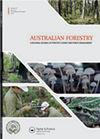Impact of flail chain characteristics on productivity, costs, bark content and fuel use when processing short-rotation Eucalyptus globulus trees to produce woodchips
IF 1.2
4区 农林科学
Q3 FORESTRY
引用次数: 0
Abstract
Infield chipping harvest systems are widely used in Australia and overseas to produce woodchips for pulp production from short-rotation plantations because they can produce uniform woodchips at low cost with high productivity from small trees. Flail chains are used in these systems to remove leaves, small branches and bark prior to chipping because these components are undesirable in paper products. Flail chains wear during use and lose links, requiring chains to be replaced. A range of flail chains is available but the most recent studies comparing flail chain performance were conducted over 30 years ago. The aim of the present study was to address this knowledge gap by comparing the performance of five flail chain types currently in use in terms of their impact on flail productivity, fuel use, woodchip bark content, chain wear and chain replacement costs. The study was conducted on a Husky Precision 2300–4 flail operating in 13-year-old Eucalyptus globulus plantations in southwest Western Australia producing export woodchips. No significant differences were found between the studied flail chains in terms of woodchip bark content, flail productivity or flail fuel use. In all cases, bark content met company standards (<0.5%). Significant differences were found between the studied flail chains in terms of their wear, link losses and replacement costs. Chain replacement costs as a proportion of total flail costs were found to be considerably lower (<1% to 4%) than those reported in previous studies (>20%).短轮作蓝桉生产木片时连枷链特性对生产力、成本、树皮含量和燃料使用的影响
在澳大利亚和海外广泛使用田间切屑收获系统,从短轮作种植园生产纸浆生产的木片,因为它们可以以低成本和高生产率从小树中生产均匀的木片。在这些系统中,连枷链用于在碎裂之前去除叶子、小树枝和树皮,因为这些成分在纸制品中是不受欢迎的。连枷链在使用过程中磨损,失去链环,需要更换链条。一系列连枷链是可用的,但最近的研究比较连枷链的性能进行了30多年前。本研究的目的是通过比较目前使用的五种连枷链类型对连枷生产率、燃料使用、木屑树皮含量、链磨损和链更换成本的影响,来解决这一知识差距。该研究是在西澳大利亚西南部生产出口木片的13年树龄蓝桉种植园的赫斯基精密2300-4连枷上进行的。所研究的连枷链在木屑树皮含量、连枷生产力或连枷燃料使用方面没有显著差异。在所有情况下,树皮含量均达到公司标准(20%)。
本文章由计算机程序翻译,如有差异,请以英文原文为准。
求助全文
约1分钟内获得全文
求助全文
来源期刊

Australian Forestry
FORESTRY-
CiteScore
3.70
自引率
4.80%
发文量
15
审稿时长
>12 weeks
期刊介绍:
Australian Forestry is published by Taylor & Francis for the Institute of Foresters of Australia (IFA) for scientific, technical, and professional communication relating to forestry in the Asia Pacific.
 求助内容:
求助内容: 应助结果提醒方式:
应助结果提醒方式:


